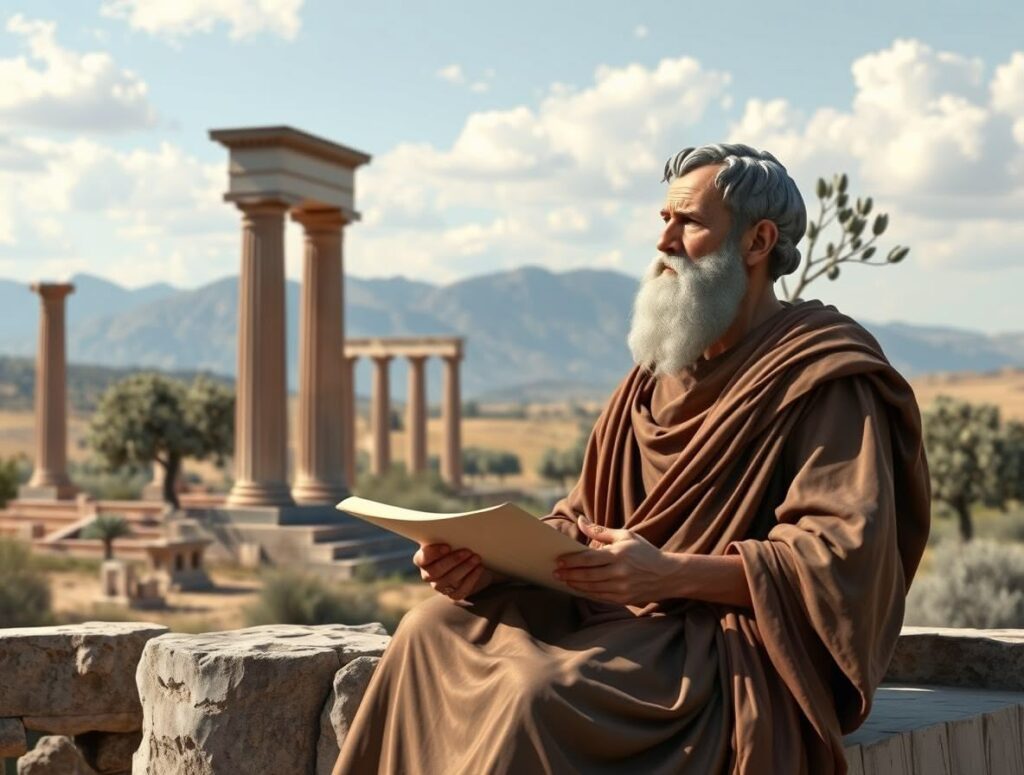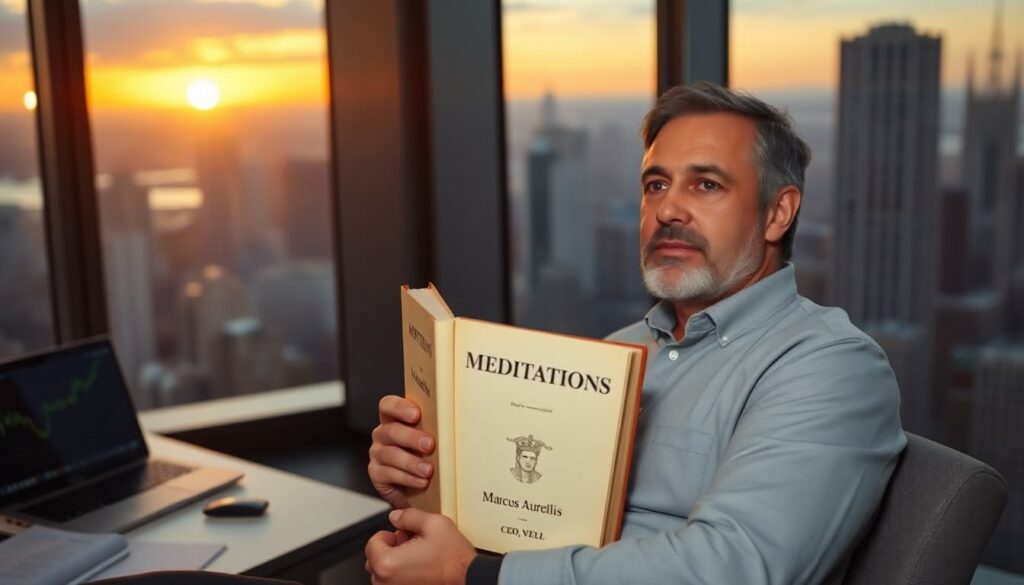The Ancient Emperor’s Playbook Hidden in Corner Offices
The most powerful CEO in Silicon Valley keeps a worn copy of a 2,000-year-old text on his nightstand. Before making critical decisions that affect thousands of employees and billions in market value, he turns to the writings of a Roman Emperor who died in 180 AD. This isn’t historical fascination—it’s strategic leadership.
While Wall Street celebrates quarterly earnings and tech evangelists herald each innovation as revolutionary, a quiet movement has taken hold among those steering the world’s most influential companies. These leaders aren’t just reading Marcus Aurelius’s “Meditations”—they’re systematically implementing his Stoic practices into their decision-making frameworks, emotional regulation strategies, and organizational philosophies.
The irony isn’t lost on those who’ve discovered this ancient wisdom. The man who ruled the most powerful empire on earth faced challenges startlingly similar to those confronting modern executives: complex organizations, competing stakeholder demands, existential threats, and the persistent pressures of leadership. Yet his philosophical approach—developed without modern psychology, management theory, or leadership coaches—provides a blueprint remarkably well-suited for today’s high-stakes business environment.
This isn’t about adopting historical curiosities or intellectual affectations. Today’s business leaders are finding that Marcus Aurelius’s practical wisdom addresses fundamental challenges that even the latest management theories often fail to solve: maintaining clarity amidst information overload, building resilience against market volatility, separating strategic signals from emotional noise, and pursuing meaningful success beyond mere profit.
As one Fortune 100 executive confided, “My MBA taught me how to analyze business problems. Marcus Aurelius taught me how to analyze myself as a leader.” The practices these executives are adopting aren’t abstract philosophical concepts but concrete mental disciplines—daily rituals and thought patterns that reshape leadership from the inside out.

The Morning Reflection: Preparing the Mind for Leadership
Marcus Aurelius began each day with a deliberate mental preparation ritual. In his own words: “When you wake up in the morning, tell yourself: The people I deal with today will be meddling, ungrateful, arrogant, dishonest, jealous, and surly.” This wasn’t pessimism but pragmatic preparation—a recognition that by anticipating difficulties, one could respond to them with reason rather than reaction.
Today’s most effective leaders have adapted this practice to modern business realities. Instead of beginning their day by reacting to the latest crisis email or headline, they carve out time for structured reflection. This modern morning ritual typically involves three components: anticipating the day’s challenges, reviewing core principles, and setting intentional mental frames.
Imagine this scenario: before opening any devices or checking messages, a CEO spends twenty minutes considering what difficult conversations, decisions, or market conditions might arise that day. They mentally rehearse responding with patience, strategic thinking, and emotional equilibrium. They review their core leadership principles and company values. Finally, they set specific intentions for how they’ll approach the day’s most important priorities.
The psychological advantage this creates is substantial. Research in cognitive priming demonstrates that our initial mental frameworks profoundly influence subsequent perceptions and decisions. Leaders who begin their day reactively—responding to whatever crisis or email demands immediate attention—surrender this advantage, allowing external circumstances to establish their mental context.
A morning reflection practice creates what psychologists call “implementation intentions”—mental scripts that prepare us to act in alignment with our values when specific triggers occur. When the market suddenly drops, when a key client threatens to leave, when an executive team member resigns unexpectedly—the leader who has mentally prepared faces these challenges from a position of philosophical readiness rather than emotional reactivity.
For many executives, this practice evolves to include reviewing strategic objectives, personal leadership values, and even physical components like breathwork or visualization. The core insight remains Aurelian: the leader who controls their mental approach to the day’s challenges gains an advantage no strategic plan alone can provide.

Negative Visualization: The Strategic Power of Premeditated Adversity
Perhaps the most counterintuitive Stoic practice gaining traction in executive suites is what philosophers called “premeditatio malorum”—the premeditation of evils. Marcus Aurelius regularly engaged in mental exercises where he vividly imagined worst-case scenarios, from personal illness to military defeat to the loss of loved ones. This wasn’t morbid pessimism but strategic psychological preparation.
In today’s business context, this practice has evolved into structured adversity planning that goes far beyond standard risk management. While conventional business planning typically focuses on maximizing upside scenarios, Stoic-influenced executives deliberately contemplate catastrophic outcomes—market collapses, product failures, reputation crises, talent exoduses—in vivid detail.
The paradoxical effect of this practice is profound psychological resilience and strategic clarity. By confronting worst-case scenarios intellectually and emotionally before they occur, leaders develop what psychologists now call “stress inoculation”—the ability to maintain cognitive function under extreme pressure. When actual crises emerge, these leaders experience them as anticipated challenges rather than shocking disruptions.
One technology CEO describes implementing this practice through quarterly “disaster sessions” with his executive team. They dedicate time to imagining specific detailed scenarios: their main product becoming obsolete overnight, their largest competitor making a game-changing acquisition, or regulatory changes decimating their business model. For each scenario, they explore not just strategic responses, but psychological and cultural ones: how would they maintain team cohesion? How would they communicate with stakeholders? What principles would guide their decisions?
Beyond resilience, this practice delivers a secondary benefit Marcus Aurelius understood: profound appreciation for current conditions. The Stoics discovered that contemplating the loss of something—health, relationships, achievements—naturally increases our gratitude for its presence. Leaders who regularly practice negative visualization often report greater satisfaction and presence, counteracting the human tendency to habituate to success and constantly shift goalposts.
This practice directly challenges contemporary business culture’s obsession with positive thinking and visualization. Where many business methodologies encourage exclusive focus on desired outcomes, Stoic-influenced leaders understand that contemplating potential failures creates both psychological stability and strategic flexibility that optimism alone cannot provide.

The Evening Examination: The Forgotten Art of Self-Assessment
At day’s end, Marcus Aurelius engaged in a rigorous self-assessment practice. He would review his actions, decisions, and responses, evaluating them against his philosophical principles rather than their external outcomes. “Did I act with justice? With self-discipline? With wisdom? With courage?” These were his metrics, not wealth accumulated or territories conquered.
Modern leaders adapting this practice have discovered its power to counteract one of the most dangerous leadership tendencies: confusing results with quality of decision-making. In business environments where outcomes are celebrated while processes are overlooked, the evening examination provides a crucial corrective.
The contemporary version of this practice often takes the form of structured reflection on the day’s leadership moments. Rather than merely reviewing what happened, Stoic-influenced executives assess how they showed up as leaders: Did they remain present during difficult conversations? Did they make decisions based on principles rather than expedience? Did they respond to challenges with emotional intelligence rather than reactivity?
One healthcare executive describes her adaptation of this practice: “Each evening, I identify three leadership moments from the day—conversations, decisions, or situations where my leadership was tested. For each, I ask three questions: Did I act according to our organizational values? Did I respond rather than react? Did I miss any opportunity to develop others?” This structured self-assessment creates a feedback loop entirely within her control, independent of external validation or criticism.
The psychological mechanism at work is what psychologists call metacognition—thinking about our thinking—which research shows is essential for developing expertise in complex domains. By regularly examining their own leadership, executives develop heightened awareness of their patterns, triggers, and opportunities for growth.
Many leaders extend this practice by documenting their reflections, creating a personal leadership journal that becomes a resource for identifying patterns and tracking growth over time. This documentation element connects directly to Marcus Aurelius’s own practice—his “Meditations” were never intended for publication but were personal notes to himself, a record of his own philosophical progress.
The evening examination serves as a powerful antidote to the external validation traps that capture many executives, who may receive ample feedback on their results but precious little on their leadership presence, decision quality, or alignment with values. By establishing an internal feedback system, leaders develop independence from the opinion rollercoaster that derails many otherwise promising executives.

Voluntary Discomfort: The Strategic Advantage of Self-Imposed Challenges
Among Marcus Aurelius’s more demanding practices was the deliberate embrace of discomfort. Though emperor of Rome with access to every luxury, he would regularly subject himself to physical hardships—cold baths, hard beds, simple food—not from ascetic self-denial but as practical training for inevitable adversity.
Today’s Stoic-influenced executives have adapted this practice into what some call “comfort zone expansion”—systematically placing themselves in challenging situations that build psychological resilience and capability. This practice stands in stark contrast to the carefully controlled environments many executives create around themselves, where administrative assistants, executive perks, and organizational hierarchies can insulate them from direct contact with difficulty.
The contemporary version of voluntary discomfort takes many forms. Some leaders practice it through physical challenges—endurance events, cold exposure practices, or fasting protocols that develop physical resilience which transfers to psychological domains. Others implement it through deliberate communication practices—regularly engaging with their harshest critics, participating in unfiltered customer feedback sessions, or placing themselves in environments where they lack status or authority.
One retail CEO describes implementing a quarterly “discomfort rotation” where he works full shifts in different front-line positions throughout his company—cashier, warehouse worker, customer service representative. Beyond the obvious organizational insight this provides, he reports that temporarily abandoning his executive authority and experiencing genuine workplace challenges creates a resilience that carries over to the executive suite. “After eight hours handling customer complaints with no ability to make policy changes, budget meetings don’t seem so stressful,” he explains.
The psychological principle underlying this practice is what researchers call “antifragility”—the capacity of some systems to become stronger when exposed to stressors. By deliberately seeking out manageable difficulties, leaders develop psychological resources that remain unavailable to those who prioritize comfort and ease. These resources include perspective-taking ability, emotional regulation skills, and confidence in their capacity to handle adversity.
Many executives report that voluntary discomfort practices help them distinguish between genuine problems and mere inconveniences—a critical discernment for leaders who must constantly prioritize their attention and resources. As one leader notes, “After voluntarily sleeping on the ground during a three-day wilderness trip, I found I had much more perspective about which office complaints warranted my attention versus which were simply preferences.”
In a business culture that often celebrates comfort as achievement, the deliberate embrace of discomfort represents a countercultural approach to leadership development that creates capabilities unavailable through conventional executive education.

The Discipline of Assent: Mastering the Space Between Stimulus and Response
Perhaps the most sophisticated Stoic practice Marcus Aurelius employed was what philosophers called the “discipline of assent”—the deliberate examination of one’s automatic judgments and impressions before accepting them as truth. In his words: “The soul becomes dyed with the color of its thoughts.” He understood that our initial interpretations of events, not the events themselves, determine our emotional and strategic responses.
In modern executive practice, this translates into sophisticated cognitive reframing techniques. Leaders trained in this approach recognize that their automatic interpretations of business events—a missed quarter, a competitor’s move, a talent departure—are provisional judgments, not objective realities. They develop the habit of questioning these interpretations before allowing them to drive decisions.
Consider this scenario: A major client unexpectedly switches to a competitor. The untrained executive mind immediately generates interpretations: “Our product is falling behind,” “Our relationship management is failing,” or “This is the beginning of a major client exodus.” These interpretations trigger emotions—fear, anger, defensiveness—which then drive reactive decisions.
The Stoic-trained executive recognizes these interpretations as provisional and creates space to examine them. They ask: “What factual evidence supports this interpretation? What alternative explanations exist? What aspects of this situation are within my control versus outside it?” This mental discipline doesn’t deny the challenge but creates space for strategic rather than reactive response.
One financial services executive describes implementing this practice through what she calls “interpretation audits.” When facing significant business developments, her team documents their initial interpretations, examines the evidence supporting each, generates alternative explanations, and only then develops response strategies. “We discovered that our first interpretations were complete stories we were telling ourselves, often with minimal evidence. Creating space between event and interpretation has probably saved us from dozens of strategic errors.”
The psychological mechanism at work is metacognitive awareness—the ability to observe our own thinking processes rather than being captured by them. Research in cognitive psychology demonstrates that this skill dramatically improves decision quality, especially under conditions of uncertainty and emotional pressure—precisely the environment most executives operate within.
Many leaders extend this practice by developing specific reframing questions for common business situations. When facing apparent failures, they might ask: “What opportunity does this create that wouldn’t otherwise exist?” When confronting difficult relationships: “What might make their behavior seem reasonable from their perspective?” When dealing with market challenges: “How might we be better positioned for this than our competitors?”
This discipline creates what psychologists call cognitive flexibility—the ability to adapt mental models in response to changing circumstances. In rapidly evolving business environments, this flexibility often proves more valuable than rigid strategic planning or fixed analytical frameworks.

The Modern Stoic Executive: Building the Inner Citadel
Marcus Aurelius wrote about developing an “inner citadel”—a fortress of mental clarity and ethical principle that remains unassailable regardless of external circumstances. For the Roman Emperor, this wasn’t abstract philosophy but practical necessity. Leading an empire facing plagues, wars, political conspiracies, and economic challenges required psychological tools beyond what conventional power provided.
Today’s executives face a different but equally demanding landscape. Market volatility, technological disruption, stakeholder activism, information overload, and intense performance pressure create a leadership environment where conventional management techniques often prove insufficient. The outer tools of leadership—strategic frameworks, financial analysis, organizational design—must be complemented by inner tools that develop the leader themselves.
The executives who have quietly adopted these Stoic practices report a fundamental shift in their leadership capacity. They describe developing a core of calm clarity that allows them to see strategic opportunities others miss, maintain team cohesion during crises, make principled decisions under pressure, and sustain their leadership energy across decades rather than burning out.
Perhaps most significantly, they report that these practices address the existential questions that conventional business education typically ignores: How do I find meaning in my leadership role beyond financial metrics? How do I maintain perspective when success and failure both seem all-consuming? How do I build a legacy based on contribution rather than achievement alone?
While Marcus Aurelius developed these practices as personal disciplines, never intending them for public consumption, today’s Stoic-influenced leaders are beginning to formalize them within their organizations. Morning reflection practices become team rituals. Negative visualization becomes part of strategic planning. Evening examinations evolve into leadership development protocols. Voluntary discomfort transforms into organizational resilience training. The discipline of assent shapes decision-making frameworks.

The Roman Emperor would likely be surprised to find his personal philosophical practices shaping 21st-century businesses. Yet the principles he articulated—focusing on what we can control, separating facts from interpretations, preparing mentally for challenges, finding opportunity in adversity, and maintaining ethical principles regardless of circumstances—prove remarkably well-suited to contemporary leadership challenges.
As artificial intelligence accelerates decision-making, global complexity increases, and business environments become more volatile, the ancient wisdom of Stoicism offers something algorithms cannot: a tested framework for developing leaders who remain clear, resilient, and principled amid chaos. The emperor’s inner practices may prove to be his most enduring legacy—one that continues to shape how power is wielded centuries after his empire fell.

